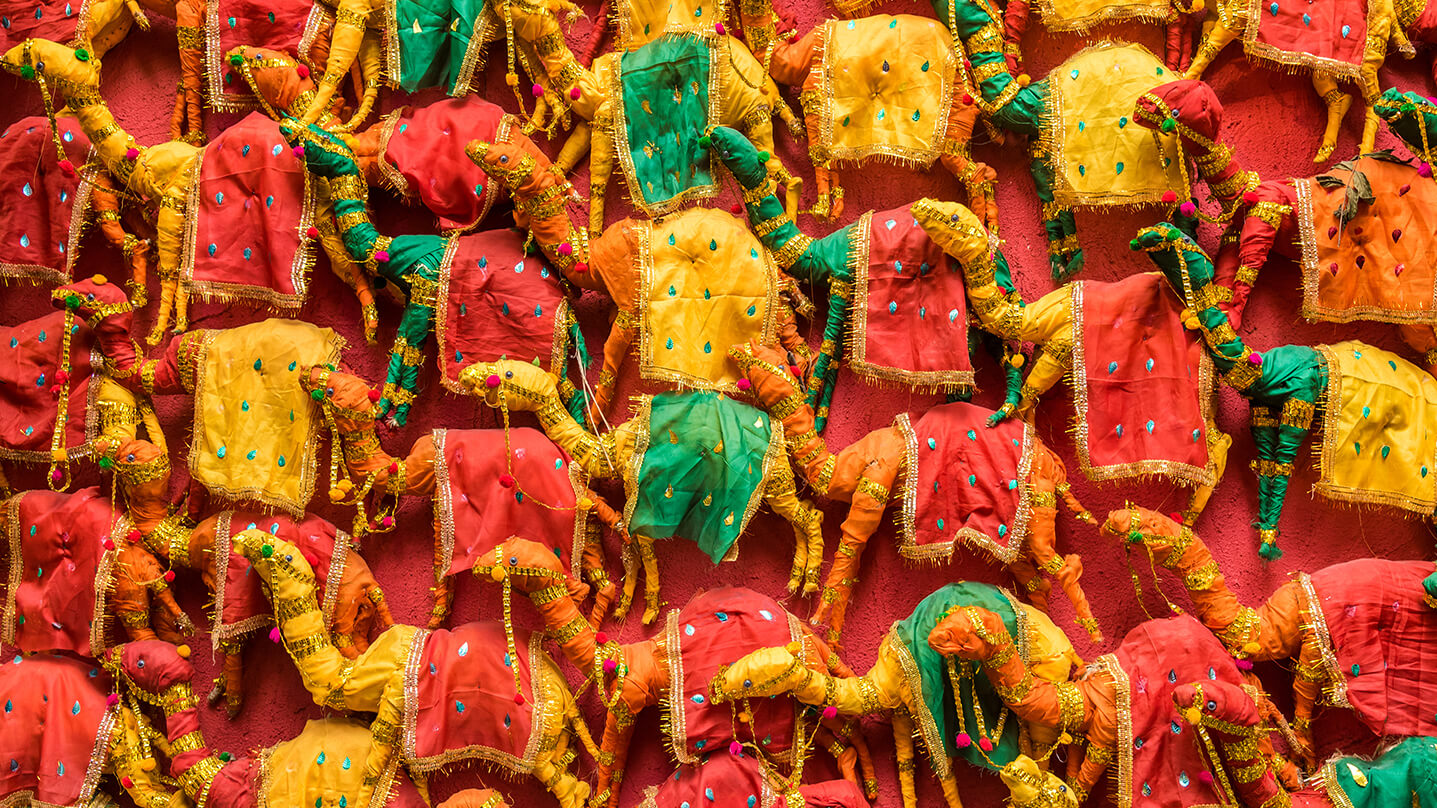JaneSthan
Rajasthan through eyes of Jane
Jane | Januray 29th, 2019
-
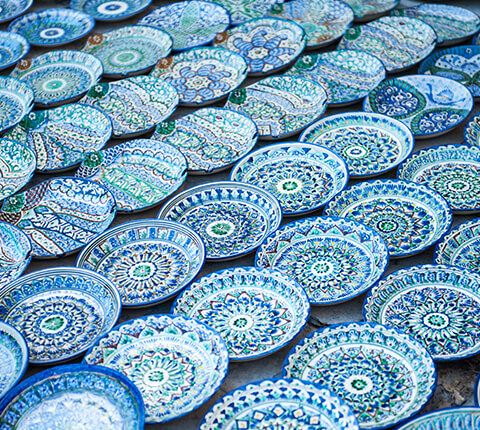
Handicrafts in Rajasthan
Each and every aspect of the Rajasthani culture and tradition is charged with art in multiple forms. Distinguished within the nation and outside for hand- created paintings, jewelry, textiles, pottery, metal works and more, the state houses excellent craftsmen, who are patronized by the government and the locals. The idea that the handicrafts of Rajasthan are only ornamental in nature gets invalidated as one goes through the standard household items used by its locals. Unique, embellished and vibrantly colorful in nature, they not only paint the otherwise dull monotone of the desert sand bright, but also articulate the depths to which art is rooted in Rajasthani souls.
-
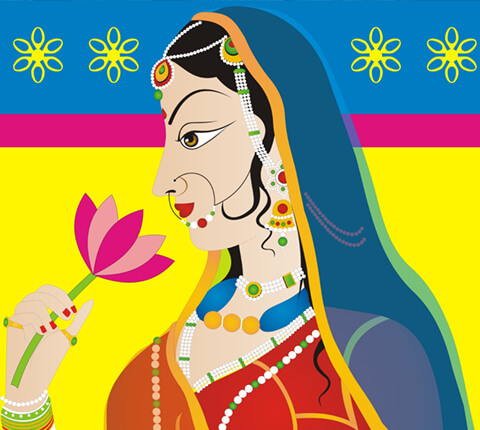
Puppets
One of the most vibrant parts of Rajasthani culture and legacy is puppet-making and puppetry. Termed as Kathputli (Kath meaning Wood, Putli meaning Dolls) in the local lingo, puppets are the oldest and also the most performed art (after Ghoomar) in the state. History has it that the puppetry began when the Bhat community in Rajasthan began using wooden dolls for string marionette art, nearly 1500 years ago. Scholars are of the thought that the Kathputli art in Rajasthan might have stemmed up in the present day Nagaur and nearby areas. Kathputli actually was a system of patronage and was supported by the Rajasthani nobles and kings (Vikramaditya of Ujjain, Prithvi Raj Chauhan etc.) who appreciated and encouraged art and craft. The artists would sing praises of their patrons and their ancestors, alongwith covering heroic tales, folk lores and epics, largely through their art form. By involving issues like illiteracy, dowry system, unemployment, women’s empowerment etc. in the shows, puppetry became a source of social and moral education too. A result of proper teamwork, puppet shows involve a lot of characters like head-puppeteers, story-tellers, anchors and of course the puppets. These wooden dolls are dressed and painted based on the characters they portray. Usually colors like, yellow, red, black, blue and green go into painting the faces of these puppets, while their hands are loaded with cotton and fabric pieces. These adorable Rajasthani handicrafts flaunt traditional attires, unless exhibiting a distinct genre in their show. No big celebration or fete in Rajasthan is ever complete without a charming Kathputli-show.
-
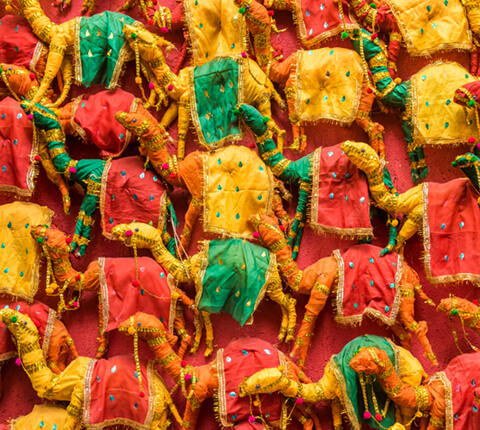
Jewelry
If there is a handicraft that symbolizes the richness of the state’s art and craft it has to be jewelry-making in Rajasthan. Right from Meenakari, Kundan, Thewa, Silver, glass to Lacquer Rajasthan has an extensive and fascinating jewelry business. Meenakari which is the enamel work refers to the exquisite art of coating engravings and grooves in ornaments with colorful enamel to lend the piece, the appearance of a picture. It is believed that this art of jewelry-making was patronized by Raja Man Singh of Udaipur, back in the 16th century. Today Jaipur serves as the hub of Meenakari art, where you can find numerous beautiful ornaments featuring different looks and themes, perfected by highly skilled craftsmen. Closely associated with Meenakari is the Kundan art of jewelry-making and it refers to stones rigged in profoundly refined gold. Although silver also gets used in this kind of the art, the whole skill set actually lies in setting the stones into the solid metal. Bikaner, Jaipur and Nathwada are the areas in Rajasthan where this art form still lives. Tewa or quasi-enameling is another form of jewelry making in Rajasthan which is specific to Pratapgarh. It uses extremely fine work in gold done generally on a base of green enamel. Thewa is an intricate and time-consuming Rajasthani handicraft that often takes a month to finish. This art dates back to the time when Mughals ruled over India. Compared to enameling is another jewelry art form, lac or lacquer, which had its birth in the 18th century Rajasthan and went on to become an important part of its culture. Created out of a resin extracted from wild trees, lac jewelries, especially bangles are the most prominent in the Rajasthan.
-
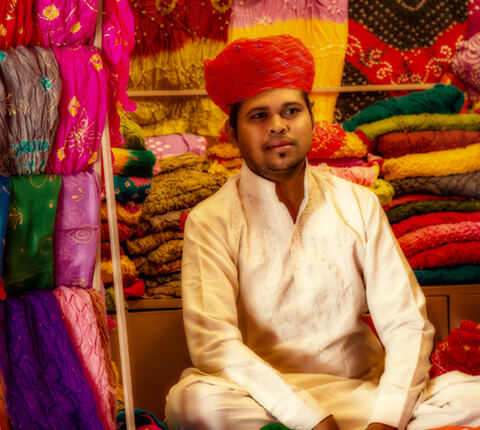
Pottery
The lands of this princely state are rich in several distinctive styles of pottery, prominent among which are terracotta and blue glazed pottery. A traditional craft of Jaipur, the blue glazed pottery has a Turko-Persian origin and is recognized for its vibrant and eye-catching blue dyed pottery items. This magnificent handicraft of Rajasthan is made out of not clay but an unusual mix of powdered quartz stone, borax, Fuller’s Earth, glue and water. The items thus made are then fired at low temperatures to give them the characteristic semi-transparent appearance. The blue glazed pottery items are mostly decorative and exhibit motifs of birds and animals. Terracotta is also hugely popular in this state and Molela village close to Udaipur is home to potters who specialize in making ceremonial images of deities. Again where Bikaner has its lac tinted pottery, Alwar is famous for its unique paper-thin pottery.
-
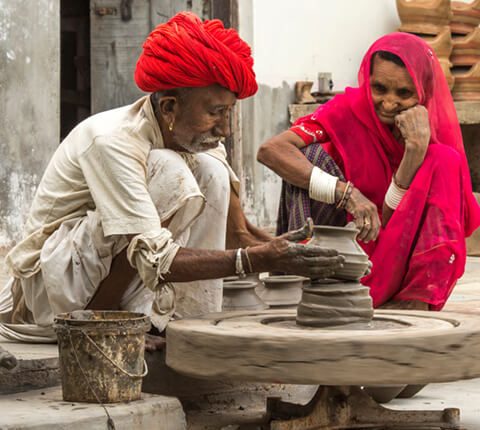
Paintings
The rich history of Rajasthani paintings is widely evident in its architectural monuments, temples, textiles and even domestic items. Courtly paintings, portraits, henna art, murals, miniature paintings and mandana are some of the many forms in which this Rajasthani handicraft breathes within the state. Numerous painting styles originated and flourished within the state under royal patronages of various art-loving rulers and finally reached the epitome of fame in between the 15th to 17th centuries. Although the art forms bore incredible diversity, the ones that left a lasting mark included – miniature paintings, gemstone paintings, kajali paintings and phad paintings. Where miniature paintings were manuscript paintings meant to be stored in albums, Phad was essentially a scroll painting done on a piece of cloth. Mandana on the other hand referred to the art of painting houses. These paintings would depict scenes from Gita, Ramayana, themes of royal heritage and were made out of colors prepared from varied items like fruits, vegetables, conch shells, precious stones and also silver and gold.
-
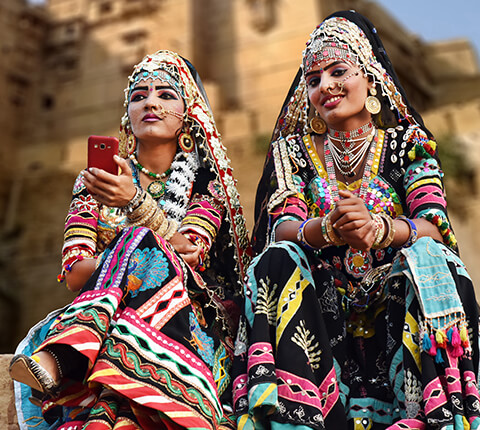
Textile
Among the handicrafts of Rajasthan that are renowned nationwide the highly specialized textiles holds a special mention. Dyed, printed or embroidered, the fabrics of this state are identified for their unique tones and hues. Each region within Rajasthan has its own color choices and use and also motifs. The full-fledged artworks on fabrics are the – Tie and Dye prints, Block prints, Sangneri, Bagru and leheriya. Also known as Bandhani, tie and dye prints are created using natural colors, resulting into large variety of patterns. Bandhani fabrics are also used for symbolic purposes, for instance red is for the bride and yellow for maternity. Created on thin cotton or silk cloth, featuring lengthy, clear patterns Leheriya prints are named after the flowing waves of a river. These prints are largely found on turbans, sarees and dupattas. Known for its geometric patterns and earthy colors, Bagru displays zigzag patterns created by natural dyeing and block printing techniques. When it comes to textiles, the popular Jaipuri carpets, Dhurries and quilts that get exported all over the world, deserve a special mention. Apart from these the Bikaneri Jail carpets and Rajasthani hand-knotted carpets with their formal designs and geometric motifs stand out too.



